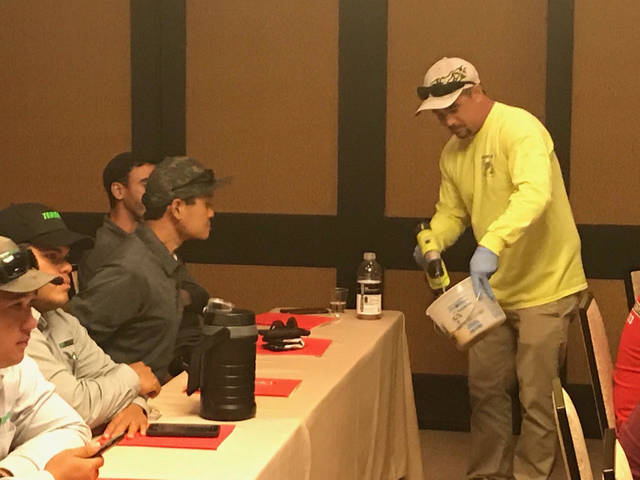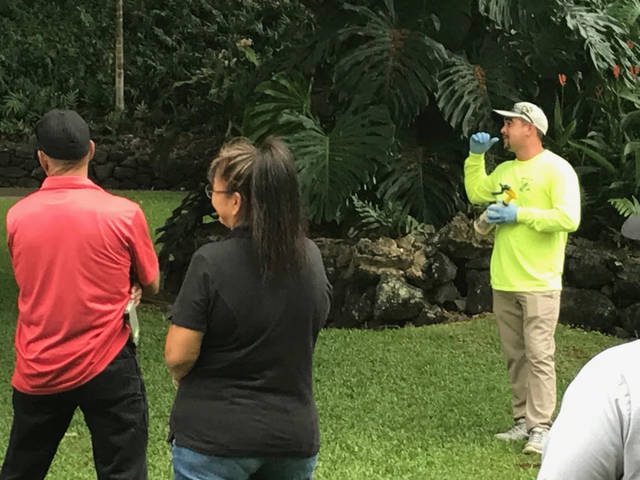KAILUA-KONA — Carolyn Dillon is on a mission to force Hawaii Island to accept an issue it has, in her opinion, ignored for far too long — little fire ants. ADVERTISING KAILUA-KONA — Carolyn Dillon is on a mission to
KAILUA-KONA — Carolyn Dillon is on a mission to force Hawaii Island to accept an issue it has, in her opinion, ignored for far too long — little fire ants.
Dillon, founder of LFA Hui, organized a tutorial for pest control operators Thursday at the Sheraton Keauhou in conjunction with Hawaii Ant Lab. Around 20 operators and employees from six pest control operations across Hawaii Island showed up to learn about LFA control, or in several cases, merely get a refresher course.
The session was part of a series of events Dillon scheduled to help arm West Hawaii’s multiple lines of defense against LFA, as the pests become more prevalent across the leeward side of the island.
A session and demonstration were held at the Four Seasons Resort Hualalai for 33 representatives from resorts and golf courses throughout Kohala in June. Following Thursday’s free workshop, Dillon also plans to convene a session for landscaping companies in coming months.
“Pest control operators are a huge part of interfacing with our community,” Dillon said. “They have individual relationships with their homeowners. They can help them survey their properties, which is really important, and provide solutions to help them manage their fire ants.”
At this point — even in West Hawaii, where the problem isn’t nearly as pervasive as it is in Hilo — management is the end goal. Pest control operators explained Thursday that eradication has become more or less a pipe dream.
“This stuff is coming,” said Bob Shima, owner and operator of Veteran Termite &Pest Control, which is expanding its Hilo-based services to the Big Island’s leeward shores. “You’re just trying to delay it.”
Efforts to manage and delay LFA have created business opportunities for pest control operators, and some in attendance Thursday have been providing LFA services for awhile. Shima said for his company, addressing the spreading threat is just about expanding to another area.
He added training and incurred cost to provide the treatments are manageable, and not just for his operation.
“Most companies already have the equipment, it’s just a matter of modifying the equipment to treat the different insect,” Shima said. “As far as cost wise, there’s not that much cost involved, except for the Tango.”
The process for Will Kill Termites &Pests is even simpler, as their expansion to Kona and beyond to deal with the issue began about two years ago.
Keith Lee, pest control field representative with Will Kill, said he and his colleagues have been treating LFA in West Hawaii on a more or less daily basis since that time. They’ve managed what he referred to as “major explosions” of LFA in several pockets from Kohala to Holualoa to Milolii.
The topography in West Hawaii, Lee said, is cause for concern. LFA take root at higher elevations, then weather events spread them out naturally.
“When Kona is getting a lot of rain, it pushes (LFA) down, and they travel very well along waterways,” he explained. “So any time you get water subsiding from flow, (LFA) are going right up the banks. They’re going to establish anywhere that water is moving them. That’s what we’re seeing happening. You’re starting to get them around Lako Street and elsewhere.”
Will Kill’s strategy has been to deal with LFA in pockets, neighborhood by neighborhood to maintain control.
Shima explained that if LFA establish in West Hawaii the way they have in Hilo and Puna, it will be “devastating” to agricultural concerns — particularly for coffee and avocado farmers, as LFA are frequently found living in trees.
Lee said he could even envision an embargo if the situation isn’t handled promptly.
“They’re going to throw a net on us, like ‘Hey, that’s the place where all the fire ants are from,’” he added.
Dillon hopes LFA control becomes a staple of Big Island pest control operations because of the business opportunity infestations present to the industry.
Community awareness was the initial goal of LFA Hui, and she added pest control participation will raise that awareness even more.
“We have the opportunity here on the Kona side to reduce infestations, and there are even instances to eradicate. Some properties can be fully eradicated,” Dillon said. “But if we continue to ignore the problem and remain uneducated about the problem, it’s really only a matter of time.”
More information about LFA and treatment options can be found at LFA Hui’s website, stoptheant.org,




